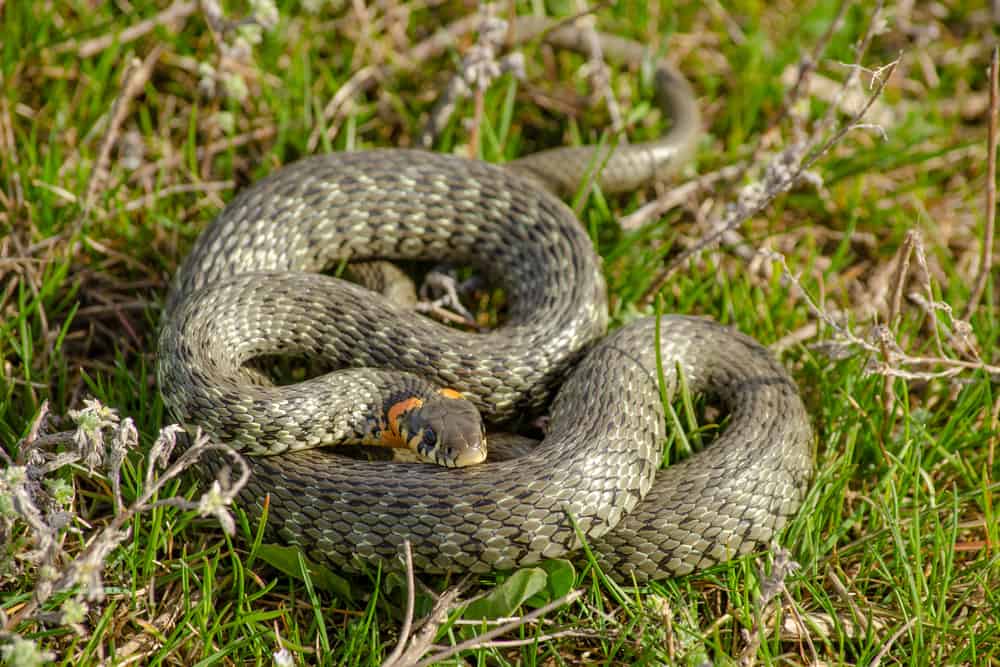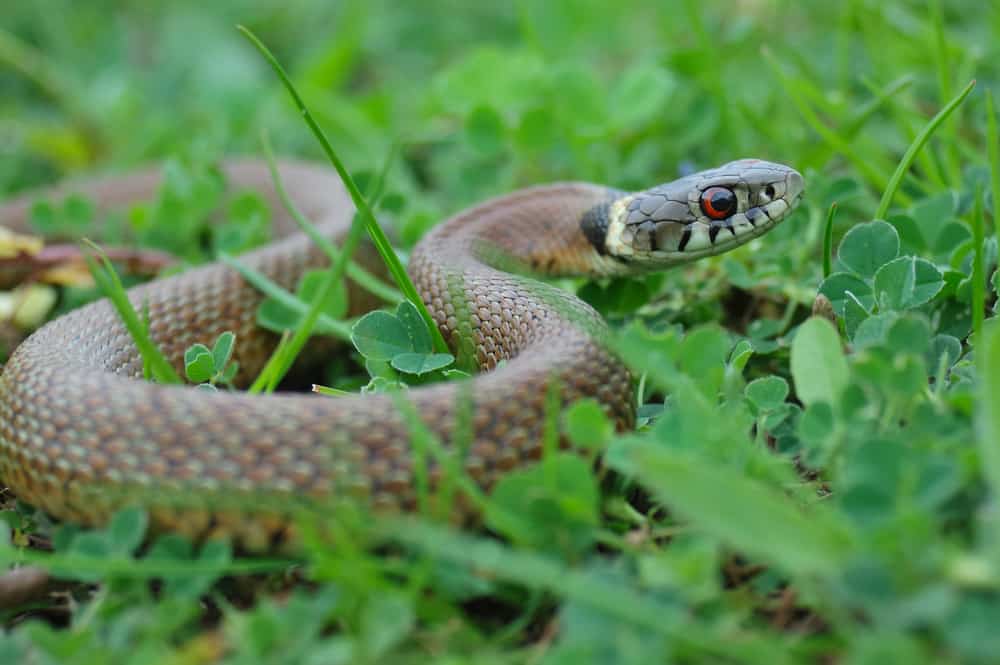There’s always an epic story to tell after the encounter. If you’ve ever come across a Grass snake, you know how interesting it can be. You probably know them for their award-winning acting skills, especially when playing dead.
So, what do grass snakes eat? Let’s explore this in detail.
Grass Snakes Habits And Biology
Grass snakes (Natrix natrix), also known as the ringed snake or water snake, are non-venomous snakes typically found near water bodies.
They mainly inhabit open woodland areas and their borders that offer adequate shelter and sufficient opportunity for thermoregulation. That is, they can maintain constant body temperature even when the surrounding temperatures differ.
Grass snakes are mainly found in Europe in Scandinavia and southern Italy. Also, you can locate them in other parts of the world, such as North-western Africa and the Middle East.
The snakes are primarily brown or dark green with a whitish or yellow collar behind their heads, hence the alternative name, ringed neck. Their colors also range from black to grey, with the darker shade being more widespread in colder regions. You can also find them near ponds.
Grass snakes mate in spring when the environmental temperatures are favorable. Females lay between 8-40 eggs in batches that hatch in about 10 weeks.
For the eggs to hatch, the environmental temperatures should range between 21-28oC (70oF-82oF) in areas of high humidity. Baby grass snakes are 18 centimeters (7 inches) long and are immediately independent.
When in danger, grass snakes have several ways to keep predators at bay. The most basic defense mechanism they employ is hissing and striking their opponent with their head. Grass snakes hardly use biting as a form of defense.
They produce a garlic-smelling fluid from their anal glands and play dead, otherwise known as thanatosis. They do this by becoming completely limp.
In some cases, grass snakes will secrete blood from their mouth and nose to convince predators that they are dead. This form of defense is known as autohaemorrhage.
Their most peculiar defense mechanisms involve raising the front section of their body and flattening their heads and necks to resemble a cobra’s hood to intimidate predators.
What Do Grass Snakes Eat In The Wild?
As previously mentioned, grass snakes inhabit areas near freshwater bodies as they are strong swimmers. These water bodies also serve as great hunting grounds. Grass snakes are carnivorous and feed primarily on animal matter.
Grass snakes tirelessly search for prey, typically on water edges, using their sight and smell to identify and keep track of them. You can also spot them lying still among Lilly pads stalking the fish.
Unlike their snake cousins, they swallow their prey whole without suffocating them using constriction. That is, without squeezing them before consumption. Their prey is usually nothing above 180 centimeters. Grass snakes will only feed on live prey.
Grass snakes usually begin by swallowing the heads of their prey first. But the direction the prey faces upon ingestion varies among different types of prey items eaten by the snake.
The size of prey that grass snakes eat increases with the size of the snake. That said, the larger snakes still prefer feeding on smaller animals.
Prey items on the grass snakes diet include:
- Amphibians – common frogs and toads serve as the main part of their diet. They will also feed on newts and salamanders on occasion.
- Rodents – such as voles and mice, are rarely eaten as they are not as easy to catch.
- Fish – are mainly eaten when grass snakes emerge from their hibernation in March because they are spawning and are easier to catch.
- Ants – are eaten on occasion to supplement the snakes’ diets with nutrients and other minerals.
- Birds
- Insect larvae (offspring).
- Lizards
Grass snakes will consume juvenile chicks like moorhens to supplement their diets. Female grass snakes occasionally feed on mice and voles more than males, but on rare occasions.
Baby grass snakes, otherwise known as hatchlings or neonates, feed on tadpoles, small fish, and new generations of frogs and toads. Some are even said to feed on earthworms, but this is yet to be proven.
Facts About Grass Snakes
All snakes are fascinating, grass snakes included. Countless facts make them unique and differentiate them from others of their species. Some of these include:
- Grass snakes bellies have markings unique to each individual. Grass snakes are identified by these markings, just as humans are by their fingerprints.
- Like most reptiles, grass snakes hibernate, usually from October, and emerge in March or April during favorable weather conditions.
- After emerging, they spend their first few days sunbathing in the same area they hibernated. This behavior is also associated with most reptiles.
- Grass snakes tend to lay their eggs in rotting vegetation, such as compost heaps that act as natural incubators for developing eggs.
- Aside from being strong swimmers, grass snakes can hold their breaths in water for a minimum of 20 minutes and a maximum of 30 minutes.
- When caught, grass snakes regurgitate food from their stomachs. The reason for this behavior is yet to be established, but scientists speculate that they do so to seem less appealing to their predators.
- Grass snakes have many threats. At the top of the list are foxes, domestic cats, birds of prey, hedgehogs, and badgers.
- Grass snakes are protected in Denmark and the United States by the Wildlife and Countryside Act since 1981, which states its illegal to sell, kill, or injure these snakes.
- The body color of grass snakes helps them to store heat and maintain their body temperatures.
- For communication, they use hissing sounds and sense vibrations around them to understand their surroundings.
- Female grass snakes are larger than males. Males reach maximum 60 centimeters (23.6 inches), whereas females can grow up to 110 centimeters in length. Adults are seven times longer than average lizards.
- Grass snakes move very fast, on water and on land. Their speed combined with their well-developed sight makes them efficient hunters.
- During their active seasons, once every year, grass snakes shed their skin. The process is known as ecdysis or molting. In these times, they tend to be very fragile and aggressive.
- Grass snakes shed their skins in groups at the same time of the year. The molting process takes about 6-10 weeks. The reason behind why they do it in groups remains unknown.
- In Northern America, the grass snake is mainly referred to as rough grass and smooth grass snake, whereas in the United Kingdom, it is commonly called the barred grass snake.
- In Baltic mythology, grass snakes were considered sacred. It was often kept as a pet, sleeping under a married couple’s bed or in a particular place near the fireplace (hearth).
- The grass snake is not only Britain’s largest species of reptile but also the most common species of snake.
- Like all other snakes, grass snakes are coldblooded and only become active and hunt when they raise their body temperatures through basking.
Frequently Asked Questions (FAQ)
Can grass snakes be kept as pets?
No, you can’t keep them as pets. Grass snakes have not been domesticated anywhere in the world so far. It is only in zoos that they are kept for conservation. It’s near impossible to provide the conditions grass snakes require in the wild in captivity.
Wild-caught snakes might also carry parasites or cause diseases. It’s not recommended to keep a grass snake as a pet.
What should I do if I find a grass snake in my garden?
In such a situation, take your children and pets (if any) indoors as they face higher risks of being attacked. Allow the snake to slither through the garden and take note of its size, pattern and double-check to be sure. It is likely to be a slow worm or a grass snake.
Grass snakes and slow worms are both native to Europe, and they resemble one another. Hence it’s slightly difficult to differentiate the two. Luckily, both don’t pose a threat to humans.
How do grass snakes live in the wild?
In the wild, grass snakes live solitary lives. Only until the mating season do they come together in large groups to pick a mating partner and find a location to lay eggs.
Are grass snakes active at night?
Grass snakes are diurnal, meaning they are mainly active during the day and at dusk. They spend the better part of their day basking in the sun either from the ground or on trees.
Grass snakes usually find a safe spot to sleep at night as they fall prey to many animals, most of which have food night vision.
Summary
Grass snakes are skilled animals, and some might even say talented. They swim, they act, and they even look the part. These snakes occupy wet areas where they highly thrive, and their favorite meal on the menu is amphibians.
There you have it. ‘’What do grass snakes eat?’’ should never be a tricky question for you to answer.


Well as a hater of snakes absolute hater., I do know that grass snakes do threaten they do they slither away button and they stop and look back and just look at you like their little bastards. I hate them I’d kill every goddamn snake on this planet if I could. They just do in my garden now I can’t believe it was terrible